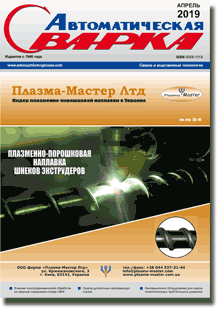| 2019 №04 (04) |
DOI of Article 10.15407/as2019.04.05 |
2019 №04 (06) |

Avtomaticheskaya Svarka (Automatic Welding), #4, 2019, pp. 30-34
Calculation of the characteristics of alternating transverse magnetic field affecting drop transition in arc welding and surfacing
A.D. Razmyshlyaev1, M.V. Ahieieva2
1SHEI «Priazov State Technical University», 7 Universitetskaya Str., 87500, Mariupol, E-mail: razmyshljaev@gmail.com
2Dobass State Mechanical Academy, 72 Akademicheskaya Str., 84413, Kramatorsk. E-mail: maryna_ah@ukr.net
It is shown that in submerged-arc surfacing with the impact of constant transverse magnetic field the coefficient of melting of electrode wires of 3-5 mm diameter increases by 25 – 30%. It is experimentally established that at the impact of an alternating field at unchanged level of the transverse component of induction, the effect of increase of the coefficient of melting depends on the frequency of this field. At increase of the field frequency up to 10 – 20 Hz, the increment of the coefficient of melting decreases to zero values. A procedure was developed for determination of the minimum level of transverse component of field induction in the electrode drop zone, at which the drop is detached from the melting electrode tip. It is shown that the effect of lowering of the coefficient of melting at increase of the field frequency is due to reduction of pulse duration. The paper gives the calculated data, allowing determination of optimum values of induction and frequency of the alternating field, at which the coefficient of wire melting at submerged-arc surfacing (welding) is increased. 8 Ref., 4 Fig.
Keywords: arc surfacing (welding), transverse magnetic field, induction, electrode melting coefficient, calculation procedure
Received: 06.03.2019
Published: 04.04.2019
References
1. Razmyshlyaev, A.D. Ahieieva, M.V. (2018) Effect of transverse magnetic field on weld geometry in repair of products. Visnyk Pryazov. DTU, 44, 77-79 [in Russian].2. Razmyshlyaev, A.D., Ahieieva, M.V. (2018) TMF influence on weld structure at the welding of 12Kh18NT. Mat. Sci. Forum, 927, 1-5. https://doi.org/10.4028/www.scientific.net/MSF.927.1
3. Razmyshlyaev, A.D., Ageeva, M.V. (2018) On mechanism of weld metal structure refinement in arc welding under action of magnetic fields (Review). The Paton Welding J., 3, 25-28. https://doi.org/10.15407/tpwj2018.03.05
4. Morozov, V.P. (2006) Analysis of conditions of refined structure formation in crystallization of weld pool metal under superposition of external periodic perturbations. Izv. Vuzov. Mashinostroenie, 8, 41-54 [in Russian].
5. Razmyshlyaev, A.D., Vydmysh, P.A., Ahieieva, M.V. (2018) Automatic submerged-arc welding under action of external magnetic field. Mariupol, PGTU [in Russian].
6. Razmyshlyaev, A.D., Serenko, A.N., Vydmysh, P.A., Ahieieva, M.V. (2015) Calculation of transverse magnetic field providing drop detachment from electrode tip in arc surfacing. Visnyk Pryazov. DTU, 30, 7-14 [in Russian].
7. Razmyshlyaev, A.D., Ahieieva, M.V. (2018) To calculation of numerical values of induction of transverse control magnetic field in head part of welding pool. Nauka ta Vyrobnytstvo: Transact., 19, 51-59 [in Russian]. https://doi.org/10.15407/tpwj2018.07.03
8. Akulov, A.I., Belchuk, G.A., Demyantsevich, V.P. (1977) Technology and equipment of fusion welding: Manual for students of higher education institutes. Moscow, Mashinostroenie [in Russian].
